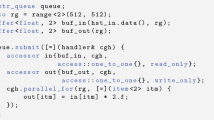Abstract
Gang scheduling is an effective scheduling policy for multiprocessing workloads with significant interprocess synchronization and is in common use in real installations. In this paper we show that significant improvement in the job slowdown metric can be achieved simply by allocating a different number of quanta to different rows “control groups” depending on the number of processes belonging to jobs in a given row. Specifically, we show that allocating the number of quanta inversely proportionally to the number of processes per job in that row results in 20 – 50% smaller slowdowns without significantly affecting mean job response time. Incorporating these suggestions in to real schedulers would require the addition of only a few lines of simple code, hence this work should have an immediate practical impact.
Access this chapter
Tax calculation will be finalised at checkout
Purchases are for personal use only
Preview
Unable to display preview. Download preview PDF.
Similar content being viewed by others
References
J.M. Barton and N. Bitar, A scalable multi-discipline, multiple-processor scheduling framework for irix. In Proc. of the IPPS’95 Workshop on Job Scheduling Strategies for Parallel Processing, pages 45–69. Springer LNCS:949, 1995.
S-H. Chiang and M. Vernon, Dynamic vs. static quantum-based parallel processor allocation. In Proc. of the IPPS’96 Workshop on Job Scheduling Strategies for Parallel Processing, pages 200–223. Springer LNCS:1162, 1996.
Thinking Machines Corporation, Connection machine cm-5 techinical summary. Technical report, nov 1992.
Intel Supercomputer Systems Divsion, Paragon users guide. Technical Report Order number 312489-003, jun 1994.
D. Feitelson. Packing schemes for gang scheduling, In Proc. of the IPPS’96 Workshop on Job Scheduling Strategies for Parallel Processing, pages 65–88. Springer LNCS:1162, 1996.
D. Feitelson and M.A. Jette, Improved utilization and responsiveness with gang scheduling. In Proc. of the IPPS’97 Workshop on Job Scheduling Strategies for Parallel Processing, pages 238–261. Springer LNCS:1291, 1997.
D. Feitelson and L. Rudolph, Metrics and benchmarking for parallel job scheduling. In Proc. of the IPPS’98 Workshop on Job Scheduling Strategies for Parallel Processing, pages 1–24. Springer LNCS:1459, 1998.
D. G. Feitelson and L. Rudolph, Gang scheduling performance benefits for finegrain synchronization. Journal of Parallel and Distributed Computing, 16 (4):306–318, December 1992.
D. G. Feitelson and L. Rudolph, Evaluation of design choices for gang scheduling using distributed hierarchical control. Journal of Parallel and Distributed Computing, 35 (1):18–34, May 1996.
D.G. Feitelson and B. Bitzberg, Job characteristics of a production parallel scientific workload on the nasa ames ipsc/860. In Proc. of the IPPS’95 Workshop on Job Scheduling Strategies for Parallel Processing, pages 337–360. Springer LNCS:949, apr 1995.
D.G. Feitelson and L. Rudolph, Distrubuted hierarchical control for parallel processing. IEEE Computer, 23 (5):65–77, 1990.
P. A. Fishwick, Simulation Model Design and Execution: Building Digital Worlds. Prentice Hall, 1995.
P.A. Fishwick, Simpack: Getting started with simulation programming in c and c++. In Proc. 1992 Winter Simulation Conference, pages 154–162, 1992.
A. Hori, H Tezuka, and Y Ishikawa, Overhead analysis of preemptive gang scheduling. In Proc. of the IPPS’98 Workshop on Job Scheduling Strategies for Parallel Processing, pages 217–230. Springer LNCS:1459, 1998.
A. Hori, H Tezuka, Y Ishikawa, N. Soda, H Konaka, and M. Maeda, Implementation of gang-scheduling on workstation cluster. In Proc. of the IPPS’96 Workshop on Job Scheduling Strategies for Parallel Processing, pages 126–129. Springer LNCS:1162, 1996.
S. Hotovy. Workload evolution on the cornell theory center ibm sp2. In Proc. Of the IPPS’96 Workshop on Job Scheduling Strategies for Parallel Processing, pages27–40. Springer LNCS:1162, 1996.
N. Islam, A. Prodromidis, M.S. Squillante, A.S. Gopal, and L.L. Fong. Extensible resource scheduling for parallel scientific applications. In Proc. Eight SIAM Conf on Parallel Processing for Scientific Computation, mar 1997.
N. Islam, A. Prodromidis, M.S. Squillante, L.L. Fong, and A.S. Gopal. Extensible resource management for cluster computing. In Proc. 1997 Int. Conf. On Distributed Computing Systems (ICDCS-97), 1997.
M. Jette, Expanding symmetric multiprocessor capability through gang scheduling. In Proc. of the IPPS’98 Workshop on Job Scheduling Strategies for Parallel Processing, pages 199–216. Springer LNCS:1459, 1998.
S.T. Leutenegger and M.K. Vernon, Performance of multiprogrammed multiprocessor scheduling policies. In Proc. 1990 ACM SIGMETRICS, May 1990.
R. K. Mansharamani and M.K. Vernon, Properties of the eqs paralle processor allocation policy. Technical Report 1192, Computer Sciences Department, University of Wisconsin-Madision, nov 1993.
J. Ousterhout, Scheduling techniques for concurrent systems. In Proc. of Distributed Computing Systesms Conference, pages 22–30, 1982.
P. Sabalvarro, S. Pakin, W. Weihl, and A.A. Chien. Dynamic coscheduling on workstation clusters. In Proc. of the IPPS’98 Workshop on Job Scheduling Strategies for Parallel Processing, pages 231–256. Springer LNCS:1459, 1998.
U. Schwiegelshohn and R. Yahyopour, Improving first-come-frist-serve job scheduling by gang scheduling. In Proc. of the IPPS’98 Workshop on Job Scheduling Strategies for Parallel Processing, pages 180–198. Springer LNCS:1459, 1998.
M.S. Squillante, F. Want, and M. Papaefthymiou, Stochastic analysis of gang scheduling in parallel and distributed systems. Performance Evaluation, 27:273–296.
F. Wang, H. Franke, M Papaefthymiou, P Pattnaik, L. Rudolph, and M. Squillante, A gang scheduing design for multiprogrammed parallel computing environments. In Proc. of the IPPS’96 Workshop on Job Scheduling Strategies for Parallel Processing, pages 111–125. Springer LNCS:1162, 1996.
F. Wang, M Papaefthymiou, and M. Squillante, Performance evaluation of gang scheduling for parallel and distributed multiprogramming. In Proc. of the IPPS’97 Workshop on Job Scheduling Strategies for Parallel Processing, pages 277–298. Springer LNCS:1291, 1997.
Author information
Authors and Affiliations
Editor information
Editors and Affiliations
Rights and permissions
Copyright information
© 1999 Springer-Verlag Berlin Heidelberg
About this paper
Cite this paper
Ghare, G., Leutenegger, S.T. (1999). The Effect of Correlating Quantum Allocation and Job Size for Gang Scheduling. In: Feitelson, D.G., Rudolph, L. (eds) Job Scheduling Strategies for Parallel Processing. JSSPP 1999. Lecture Notes in Computer Science, vol 1659. Springer, Berlin, Heidelberg. https://doi.org/10.1007/3-540-47954-6_5
Download citation
DOI: https://doi.org/10.1007/3-540-47954-6_5
Published:
Publisher Name: Springer, Berlin, Heidelberg
Print ISBN: 978-3-540-66676-9
Online ISBN: 978-3-540-47954-3
eBook Packages: Springer Book Archive




